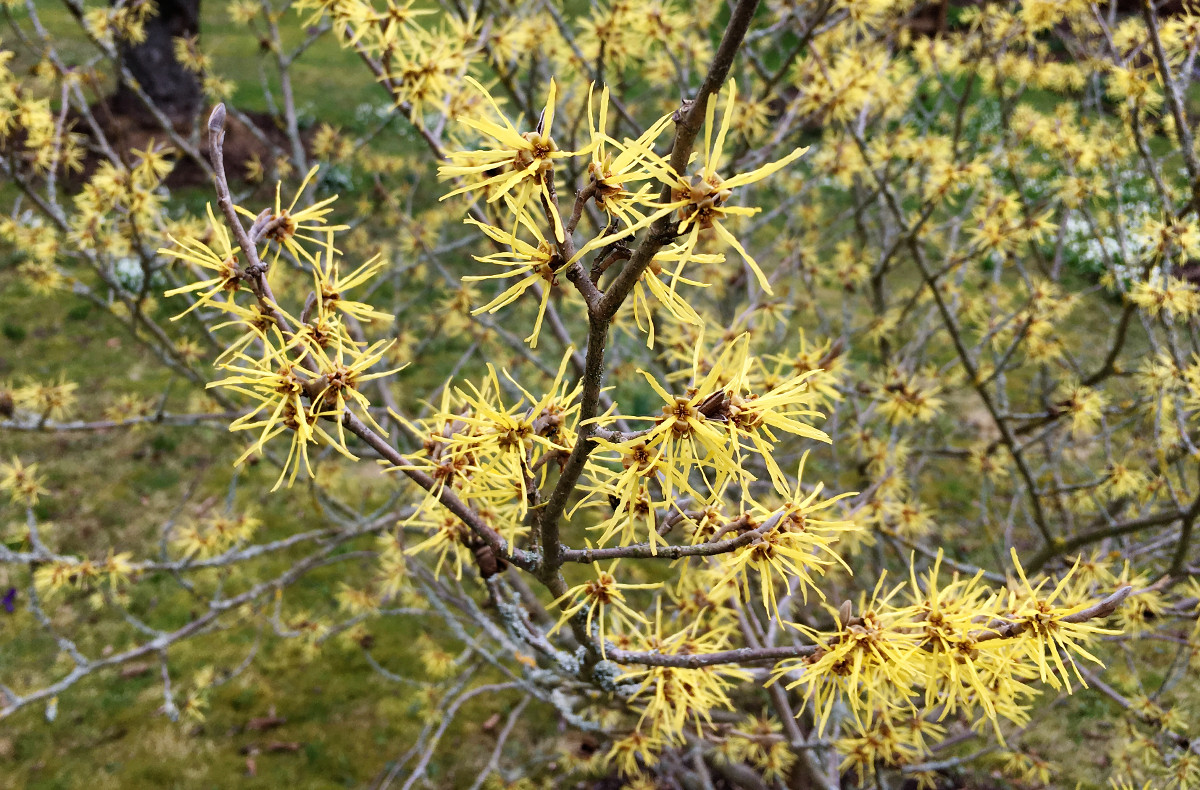Hamamelis virginiana L. - Hamamelidaceae - Virginian witch hazel, witch-hazel, Virginische Zaubernuss, Hexenhasel, Hamamelis
Deciduous shrub or small tree, up to 6m high, native to atlantic and central North America; branches with zigzag pattern between the nodes.
„Hamamelis virginiana exhibits a complex range of variation, not easily reconciled taxonomically, especially in the leaves and flowers. In the northern part of the range, the leaves are larger, averaging 9 × 2.6 cm, the petals are bright yellow, and the plants are normally shrubby. In South Carolina, Georgia, and Florida, the leaves are usually smaller, averaging 6.2 × 4.1 cm, the petals are distinctly pale yellow, and the plants sometimes attain small tree proportions, to 30 cm in trunk diameter. Such plants have been referred to as H . virginiana var. macrophylla . On the Ozark Plateau, H . virginiana and H . vernalis are sympatric. There the petals of H . virginiana are often reddish at the base, indicating the role of hybridization in that part of the range. Infraspecific taxa are not recognized for H . virginiana because no consistently defined pattern of variation or geographic correlation can be identified with this plant.“
http://www.efloras.org/florataxon.aspx?flora_id=1&taxon_id=220006023
Products of the twigs wih leaves (Hamamelidis folium et cortex) are used to treat diarrhea, as a gargle and mouth rinse for inflammation of the gums and throat, skin ailments including wounds, bruises and abrasions, varicose veins, and haemorrhoids. Hamamelis water is made by steam distillation with water to which ethanol is added at the end. The product contains 15%(vol) ethanol and 10-80ppm essential oil.
[Medicinal Plants of the World. Ben-Erik Van Wyk and Michael Wink, Pretoria 2004, 164]
[Hagers Handbuch der Pharmazeutischen Praxis, Springer 2010]
„A crude hydroalcoholic extract from Hamamelis virginiana bark was subjected to ultrafiltration (UF) with a cut-off limit of 3 kDa to obtain a higher and a lower molecular weight fraction. Characterisation of the fractions was attempted with TLC, HPLC, acidic hydrolysis, and chromatography over Sephadex LH-20. The UF-concentrate was shown to consist mainly of oligomeric to polymeric proanthocyanidins (PA). This fraction was found to exhibit significant antiviral activity against Herpes simplex virus type 1 (HSV-1).“
[Antiviral and antiphlogistic activities of Hamamelis virginiana bark., Erdelmeier, C. A., Cinatl Jr, J., Rabenau, H., Doerr, H. W., Biber, A., Koch, E., Planta medica, Vol.62(3), 1996, 241-245]
„…the effects of tannins obtained from various plant sources on the activity of 5-LOX and AT were examined. With IC50 values ranging from 1.0 to 18.7 muM, hamamelitannin and the galloylated proanthocyanidins isolated from Hamamelis virginiana L. were found to be most potent inhibitors of 5-LOX.“
[Dual inhibitory activities of tannins from Hamamelis virginiana and related polyphenols on 5-lipoxygenase and lyso-PAF: acetyl-CoA acetyltransferase., Hartisch, C., Kolodziej, H., von Bruchhausen, F., Planta medica, Vol.63(2), 1997, 106-110]
„… volatile fractions were obtained by water distillation from the entire fresh leaves and freshly collected bark in 0.13 % and 0.09% yields, respectively, on dry weight basis… Whereas the product of bark distillation was found to typically contain mainly sesquiterpenoids (15.35%) with α-ylangene, α-amorphene, γ-bisabolene, trans-nerolidol, α-eudesmol as the most abundant representatives, that obtained from the leaves included distinct monoterpenoids (linalool, α-terpineol, geraniol) with fairly high contents… With reference to the alleged biologically active fraction containing carbonyl components, the volatiles of the bark were found to contain a relatively higher level of aliphatic aldehydes and ketones (7.7%) compared with that of the leaves (4.6%). The presence of hex-2-enal and 6-methyl-hepta-3,5-dien-2-one, commonly listed as typical Hamamelis
ketones, cannot be confirmed by this study… For the bark and leaf distillation product, we found 6,10,14-trimethylpentadecan-2-one to be present in relatively high amounts (ca 0.7 %), thus being a better common representative of Hamamelis ketones than the above-mentioned constituents. Within the group of aliphatic
aldehydes, nonanal (2.72 %) and hexacosanal (0.91 %) were the main Hamamelis ketones in the bark and leaf distillate, respectively… Compounds with 13 carbons such as the vitispiranes, riesling acetal, 1,1,6-trimethyl-1,2-dihydronaphthalene, 1,1,6-trimethyl-1,2,3,4-tetrahydronaphthalene, trans-β-damascenone,
and hydroxydihydroedulan are rare essential oil components, accounting for ca 0.4%. The diterpenes manoyloxide, geranyl-linalool isomer-4, kaurene and manool were altogether identified in the leaf and bark product at 0.62% and 0.99%, respectively; geranyllinalool isomer-4 and manoyl oxide being the main components in both distillates.“
[Study on the composition of the volatile fraction of Hamamelis virginiana., Engel, R., Gutmann, M., Hartisch, C., Kolodziej, H., Nahrstedt, A., Planta medica, Vol.64(3), 1998, 251-258]
„… two major classes of constituents, namely polymeric proanthocyanidins and polysaccharides were isolated from Hamamelis bark and tested concerning their influence on proliferation and differentiation of cultured human keratinocytes. While the polysaccharide fraction, consisting mainly of arabans and arabinogalactans, did not effect human keratinozytes, the proanthocyanidins strongly increased the proliferation of the cells, while the differentiation was not influenced significantly. Within a preliminary cumulative in vivo study on SLS-irritated skin, proanthocyanidins (ProcyanoPlus) were proven to reduce transepidermal water loss and erythema formation. Furthermore, a clinical scoring indicated that procyanidins can influence irritative processes significantly.“
[High molecular compounds (polysaccharides and proanthocyanidins) from Hamamelis virginiana bark: influence on human skin keratinocyte proliferation and differentiation and influence on irritated skin., Deters, A., Dauer, A., Schnetz, E., Fartasch, M., Hensel, A., Phytochemistry, Vol.58(6), 2001, 949-958]
„Witch hazel (Hammamelis virginiana) bark is a rich source of both condensed and hydrolizable oligomeric tannins… The high content in pyrogallol moieties may be behind the effect of witch hazel phenolics on skin cells.“
[Highly galloylated tannin fractions from witch hazel (Hamamelis virginiana) bark: electron transfer capacity, in vitro antioxidant activity, and effects on skin-related cells., Touriño, S., Lizárraga, D., Carreras, A., Lorenzo, S., Ugartondo, V., Mitjans, M., Torres, J.L., Chemical research in toxicology, Vol.21(3), 2008, 696-704]

Köhler, F.E., Medizinal Pflanzen, vol. 3: t. 39 (1890)
http://www.plantillustrations.org/species.php?id_species=492796

Hamamelis virginiana flowering in late winter, Author: Andreas Kraska CC BY-SA 3.0
